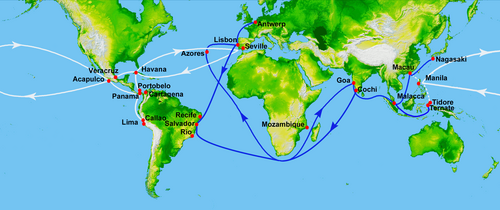
Back Silwervloot Afrikaans أسطول الكنز الإسباني Arabic Сребърен флот Bulgarian Flota d'Índies Catalan Silberflotte German Arĝentfloto Esperanto Flota de Indias Spanish Indietako Ontziteria Basque Flotte des Indes French Frota de Indias Galician

The Spanish treasure fleet, or West Indies Fleet (Spanish: Flota de Indias, also called silver fleet or plate fleet; from the Spanish: plata meaning "silver"), was a convoy system of sea routes organized by the Spanish Empire from 1566 to 1790, which linked Spain with its territories in the Americas across the Atlantic. The convoys were general purpose cargo fleets used for transporting a wide variety of items, including agricultural goods, lumber, various metal resources such as silver and gold, gems, pearls, spices, sugar, tobacco, silk, and other exotic goods from the overseas territories of the Spanish Empire to the Spanish mainland. Spanish goods such as oil, wine, textiles, books and tools were transported in the opposite direction.[1][2]
The West Indies fleet was the first permanent transatlantic trade route in history. Similarly, the related Manila galleon trade was the first permanent trade route across the Pacific. The Spanish West and East Indies fleets are considered among the most successful naval operations in history[3][4] and, from a commercial point of view, they made possible key components of today's global economy.[5]
- ^ Marx, Robert: Treasure lost at sea: diving to the world's great shipwrecks. Firefly Books, 2004, page 66. ISBN 1-55297-872-9
- ^ Marx, Robert: The treasure fleets of the Spanish Main. World Pub. Co., 1968
- ^ Walton, p. 189
- ^ Konstam, Angus and Cordingly, Daviv (2002).The History of Pirates. The Lyons Press, p. 68. ISBN 1-58574-516-2
- ^ Walton, p. 191